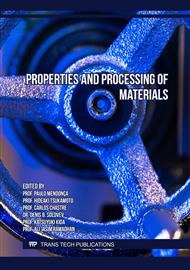p.23
p.31
p.41
p.49
p.55
p.61
p.67
p.73
p.79
Effect of the Weld Deposit Thickness on the Impact Strength of Heat-Affected Zone of the Welded Joint
Abstract:
The methodology has been developed to show the functional connection of the impact strength of the heat-affected zone metal of welded joints with weld deposit thickness and, accordingly, with the consumption of welding materials during electric arc welding while constructing and repairing various metal structures and pipeline systems operating in conditions of low climatic temperatures. To reach the objective of the paper, rational intervals of cooling rates of the HAZ metal during welding low-alloy pipe steels were used, and the calculated dependences from the existing works were modified. The methodology allows increasing cold resistance of welded joints of steels of mass use by regulating the weld deposit thickness and welding consumables during electric arc welding while constructing and repairing various metal structures and pipeline systems operating in extreme conditions of the North.
Info:
Periodical:
Pages:
55-59
Citation:
Online since:
April 2023
Authors:
Keywords:
Price:
Сopyright:
© 2023 Trans Tech Publications Ltd. All Rights Reserved
Share:
Citation:


